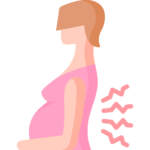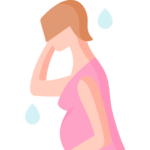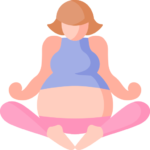 Please call maternity triage on 01324 567098 (open 24 hours 7 days a week) if experiencing any of the following:
Please call maternity triage on 01324 567098 (open 24 hours 7 days a week) if experiencing any of the following:
- Baby is moving less than usual or there is a change in the pattern of movements
- Vaginal bleeding
- Severe abdominal pain
- Wave like abdominal pain
- Severe headaches
- Changes in vision
- Severe swelling
- Changes in bladder control (unable, finding it hard to start or loss of control)
- Changes in bowel control (reduced awareness you need to empty or loss of control)
- Numbness around your back passage
- Extreme pain or inability to weight bear through your leg(s)
- Sudden loss of leg length
- If you have had a significant trauma to the back or pelvis eg. fallen down the stairs
See your GP if experiencing any of the following:
- Constipation
- Symptoms of urinary tract infection (pain on passing urine, urgency, frequency)
- Symptoms of vaginal infection
- Minor injury to the back or pelvis
Pregnancy-related Pelvic Girdle Pain (PPGP)
- What is Pregnancy-related Pelvic Girdle Pain (PPGP)?
- What causes PPGP?
- How to improve symptoms of PPGP (self-management strategies)
- Need more help?
What is Pregnancy-related Pelvic Girdle Pain (PPGP)?
Unfortunately, PPGP is very common during pregnancy. Approximately 1 in 5 people will experience PPGP at some point in their pregnancy. Firstly we would like to acknowledge that this condition while often mild and manageable for some can be an extremely debilitating for others and have far reaching effects on their daily life. The sooner it is identified, the better it can be managed.
PPGP normally presents as persistent discomfort or pain anywhere in the region of the pelvis:
- Lower Back
- Buttocks
- Pubic Bone
- Groin
- Hips
- Thighs
What causes PPGP?

We USED to think that PPGP was caused by:
- hormonal changes causing a slight softening of the tissues in preparation for growing bump and birth.
These changes do happen in all pregnancies but we now know the pelvic remains strong and stable and these changes do not directly cause pain.

Because of recent research over the last 5-10 years we NOW KNOW that PPGP is caused by:
- The huge demand on your body and hormonal changes during pregnancy naturally ‘turns up the sensitivity’ of the nervous system, these changes make us more alert to what is happening in our body, particularly to things that are happening inside and around the pelvis.
- The increased sensitivity can make our body function in a more protective way; this can result in our muscles feeling tight or our movement feeling difficult, stiff or painful.
Risk factors for developing PPGP
Research has shown you are more likely to develop PPGP if you have experienced one or more of the following:
- A history of low back pain or PGP
- High BMI
- Smoker
- Depression and/or anxiety
- A heavy work load in pregnancy
- Not been satisfied or being unsupported at work
- Belief that the pain will not improve
How to improve symptoms of PPGP (self-management strategies)
The good news is there are lots of ways you can improve your symptoms of PPGP.
The most effective way to improve PPGP is to reduce the sensitivity of your nervous system. There are many ways you can do this:
- Understand Pain
- Understand Your Body
- Understand your energy system
- Modify Your Daily Activities
- Exercise
- Nutrition and hydration
- Evoke The Relaxation Response
- Pain Relief options
Understand Pain

Think of pain like your brain’s alarm system going off; your alarm system goes off when your brain feels under threat. Your brain needs a way to communicate this to you and that is pain.
Your brain may feel under threat when it is trying to cope with too many demands and becomes overwhelmed.
When you experience pain it does not always mean that the body or pelvis is damaged, but what you are feeling is very real pain.
Understand your Body

Many people have been given outdated information about their bodies which have caused beliefs such as:
- ‘My pelvis is misaligned’
- ‘My pelvis is unstable’
- ‘The joints in my back are of place’
- ‘The discs in my back have slipped’
These beliefs only drive worry about the structural integrity of your body and create fear of movement. Your back and pelvis are made up of the strongest joints in your body and do not become unstable or misaligned in pregnancy.
Understand your Energy System

Growing a baby can feel exhausting from early on in pregnancy. Try to be mindful of your energy levels during your day as this directly contributes to the sensitivity of your nervous system.
When your energy levels are running low, your alarm system is more likely to go off and create pain and fatigue (remember this is your body’s way of communicating with you).
Try to modify your daily activities so you are not draining your energy too quickly.
Modify Daily Activities
Plan ahead / Modify timing of tasks
- Aim to complete larger activities (e.g. walking the dog, supermarket shopping) at a time of day when your energy levels are higher (i.e. not after a long day at work, as this tends to be when your nervous is more sensitive).
TIP: for most people, the morning (if you have had good quality sleep) tends to be when the nervous system is less sensitive.
Sleep
- Aim for 7-9 hours of sleep within 24hrs. If your sleep is broken due to discomfort or/and frequent toilet trips overnight, try to catch up on sleep during the day having naps where possible.
Accept help
- Pregnancy can be tough especially if you already have young children.
- Accept help with childcare, nursery/school drop offs/pick- ups.
- Delegate housework and other household chores which will help you to slow down and prioritise others activities that may help you to calm your nervous system like rest and sleep.
Other advice (only applicable if you are finding difficult)
- Sit down when getting dressed.
- When sleeping, place a pillow in between your legs.
- Try getting in/out of bed and turning in bed via your hands and knees (try not to hold your breath or brace).
- If sitting for long periods, take regular breaks and try sitting on a gym ball.
- Arrange a meeting at work to complete your risk assessment and discuss modification of work duties.
Exercise
Exercise is one of the best ways to decrease the sensitivity of your nervous system and release your own natural pain relief and can therefore help to decrease your PPGP.
Many people report feeling anxious about exercising in pregnancy however there is no evidence that exercise is harmful!
It is also perfectly safe to continue exercises from pre-pregnancy, although some modifications may need to be made such as reducing the intensity or impact of your chosen exercise.
Although there are no absolute restrictions to exercising in low-risk pregnancy it is recommended that you:
- Don’t bump the bump – avoid contact, high risk, and extreme sports
- Avoid lying flat for long periods on your back after 19 weeks
- Keep hydrated and avoid overheating
- Listen to your body and adapt exercise if causing discomfort
- Avoid temperatures that are too hot or too cold
- Avoid high altitudes or low depths
- Try not to get too breathless – you should be able to still have a conversation
Please see this leaflet for further information on exercising with Pelvic Girdle Pain (please refer to Section 6 for some examples of gentle exercises).
If you are having a high risk pregnancy, or are not keeping well please discuss exercise with your obstetric team.
We recommend if you have symptoms of PPGP you consider doing some:
- pregnancy yoga
- swimming
Both these type of exercises are low impact, calming and great for reducing sensitivity in your nervous system (the best way to reduce pain).
Nutrition & Hydration
Ensure you are eating plenty of nutrient dense foods like fruit and veggies! If you are struggling with nausea or vomiting try small snacks throughout the day instead of large meals. If your calorie intake is low this will affect your energy levels which will affect your pain!
Keep well hydrated by drinking between 1.5 -2L of fluids per day.
Visit NHS Inform for more information.
Evoke the Relaxation Response
Finding moments of calm throughout the day will help to desensitize your nervous system. Set time aside (can be as little as 10 minutes) and practise:
- Deep diaphragmatic breathing
- Gentle, fluid, mindful exercise – think yoga or swimming
- Meditation / Mindfulness
Other ways to evoke the relaxation response:
- Anything that helps you to relax
- Do something that you enjoy
- Meet with friends and/or family who make you laugh
- Take regular baths
- Spend more time in nature or with pets


Pain relief
There is a variety of pain relief options available in the community for you to consider if you are struggling to cope with your PPGP symptoms:
- Analgesic medication
- Heat/Cold therapy
- TENS machine
- Manual therapy such as massage
- Acupuncture
Please discuss pain relief options with your GP, Pharmacist, midwife, or obstetric consultant.
Resources
Please see this leaflet for further information on Pelvic Girdle Pain.
Need more help?
If you are finding it difficult to manage your PPGP after reading and following the information above, please discuss with your midwife or obstetrician and they will refer you to NHS Forth Valleys Pelvic Health Physiotherapy team for individualised assessment and discussion your treatment options.
NHS Forth Valley Pelvic Health physiotherapy treatment may include:
- Individualised advice
- Exercises
- Hands on treatment such as manual therapy or massage
- Other types of pain relief such as acupuncture or TENS
- Provision of equipment (bands/ belt/ crutches)
If you do not feel physiotherapy assessment is required but would like some equipment, you may request a support band (Tubigrip), elbow crutches or wrist splints using the link below (please note this is a provision of equipment only service, you will not be seen by a physiotherapist).
- Complete this form to request equipment.



